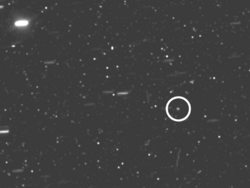Astronomy:Bestla (moon)
 Bestla imaged by the Cassini spacecraft in September 2015 | |
| Discovery | |
|---|---|
| Discovered by | Scott S. Sheppard David C. Jewitt Jan T. Kleyna Brian G. Marsden |
| Discovery date | 2004 |
| Designations | |
Designation | Saturn XXXIX |
| Pronunciation | /ˈbɛstlə/ |
| S/2004 S 18 | |
| Orbital characteristics [1] | |
| 20129000 km | |
| Eccentricity | 0.521 |
| Orbital period | −1083.6 days |
| Inclination | 145.2° |
| Satellite of | Saturn |
| Group | Norse group |
| Physical characteristics | |
| Mean diameter | 7+50% −30% km[2] |
| Rotation period | 14.6238±0.0001 h[2] |
| Apparent magnitude | 23.8 |
Bestla /ˈbɛstlə/ or Saturn XXXIX is a retrograde irregular moon of Saturn. Its discovery was announced by Scott S. Sheppard, David C. Jewitt, Jan Kleyna, and Brian G. Marsden on 4 May 2005, from observations taken between 13 December 2004 and 5 March 2005.
Description
Bestla is about 7 kilometres in diameter, and orbits Saturn at an average distance of 20,192,000 km in 1088 days, at an inclination of 147° to the ecliptic (151° to Saturn's equator), in a retrograde direction and with an eccentricity of 0.5145.[3] Early observations from 2005 suggested that Bestla had a very high eccentricity of 0.77.[4] Like many of the outer irregular moons of the giant planets, Bestla's eccentricity may vary as a result of the Kozai mechanism. Bestla's rotation period is 14.6238±0.0001 hours.[2] Like Kiviuq, it is likely to be a contact binary or binary object, as its light curve has strong variation in brightness and a plateau-like maximum not seen in the other irregulars.[5]
Name
This moon was named in April 2007 after Bestla, a frost giantess from Norse mythology, who is a mother of Odin.
References
- ↑ S.S. Sheppard (2019), Moons of Saturn, Carnegie Science, on line
- ↑ 2.0 2.1 2.2 Denk, T.; Mottola, S. (2019). "Cassini Observations of Saturn's Irregular Moons". 50th Lunar and Planetary Science Conference. Lunar and Planetary Institute. https://www.hou.usra.edu/meetings/lpsc2019/pdf/2654.pdf.
- ↑ Jacobson, R.A. (2007-06-28). "Planetary Satellite Mean Orbital Parameters". JPL/NASA. http://ssd.jpl.nasa.gov/?sat_elem#saturn.
- ↑ Brian G. Marsden (2005-05-03). "MPEC 2005-J13 : Twelve New Satellites of Saturn". Minor Planet Center. http://cfa-www.harvard.edu/mpec/K05/K05J13.html.
- ↑ Denk, T.; Mottola, S.; Bottke, W. F.; Hamilton, D. P. (2018). "The Irregular Satellites of Saturn". Enceladus and the Icy Moons of Saturn. 322. University of Arizona Press. pp. 409–434. doi:10.2458/azu_uapress_9780816537075-ch020. ISBN 9780816537488. Bibcode: 2018eims.book..409D. https://tilmanndenk.de/wp-content/uploads/DenkEtAl2018_IrregularMoons.pdf.
External links
- Saturn's Known Satellites (by Scott S. Sheppard)
- Jewitt's New Satellites of Saturn page
- IAUC 8523: New Satellites of Saturn[yes|permanent dead link|dead link}}] May 4, 2005 (discovery)
- IAUC 8826: Satellites of Jupiter and Saturn[yes|permanent dead link|dead link}}] April 5, 2007 (naming the moon)
- raw Images
 |


